The use of low-quality fuel leads to damage to both the engine power system and the mechanical parts of the engine. The only barrier to various contaminants is the fuel filter. But its resource is limited, so replacement is required from time to time. After reading the article, you will learn how to change any type of fuel filter and find out when they need to be replaced.
When to change the fuel filter
The answer to the question - when to change the fuel filter lies in its device. After all, the filter is a pipe blocked by a cardboard (sometimes metal) element, which is permeable to fuel and insurmountable to dirt. Read more about the design of this important unit in the article (Fuel filter).
The average mileage of a car before replacing the filter is 20 - 30 thousand kilometers, provided that the car is filled with only high-quality fuel. Therefore, it is desirable to reduce the mileage to 15 - 20 thousand kilometers, because it is not known in what conditions the fuel was stored, how it was transported. If you refueled at an unknown gas station and do not know what quality their fuel is or the car has traveled more than 50 thousand kilometers since the last washing of the fuel tank, reduce the mileage to 10 - 15 thousand kilometers. This will slightly increase your spending on the purchase of a new filter, but it will save the engine and fuel system from damage.
How to replace the fuel filter
Filter replacement technology depends on its type and location. Below you will read a detailed step-by-step description of the work on replacing any type of filter, and you will be able to choose the technology that suits your car. Remember to open the fuel tank cap before changing any fuel filter to relieve pressure in the system. When installing the filter, do not confuse the direction of fuel flow, it is marked with an arrow on the filter housing. Or the outlet tube is marked with an arrow.
To replace you will need:
- new filter;
- flat screwdriver;
- clean rag.
Place a rag under the filter so that leaked fuel does not stain the engine compartment. Use a screwdriver to unscrew the clamps that secure the inlet and outlet fuel hoses. Slide the clamps away from the filter. Remove one hose (it doesn't matter which one) and quickly lift it and the filter up with the second hose on to minimize fuel spillage. If possible, attach the hose to something (can be put between units or pipes) and remove the second hose from the filter. Take a new filter and insert it first into one hose, then into another. Do not confuse the direction of fuel movement, it is marked on the filter with an arrow on the body. Put the clamps on the filter legs and tighten them. Pump up fuel with a manual or electric pump (turn on the ignition on injection engines) and make sure that there are no leaks from under the clamps. Start the engine and watch the filter for 3 to 5 minutes to make sure there are no leaks.
Replacing the manual filter on a diesel vehicle
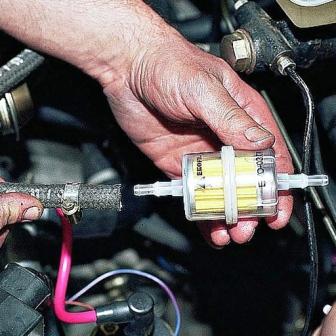
To replace you will need:
- new filter;
- puller;
- flat screwdriver;
- clean rag.
Place a cloth under the filter. Try unscrewing it by hand (on most vehicles you need to turn it clockwise). If that doesn't work, use an oil filter remover (available at any auto shop). After unscrewing the filter, carefully remove it and screw in a new one. Tighten lightly (0.5 - 1 kg). If you have a water sensor installed, then disconnect its connectors from the block, then unscrew it from the old filter and screw it into the new one. Loosen the fuel return (return) bolt from the injection pump or disconnect the return hose (you will need to unscrew the clamp) from the tube and place a transparent jar under it. 10 - 15 times pump fuel with a hand pump, watch the fuel exit into the jar. At first it will not go much (a few drops), then it will stop, and then it will go again. As it appears again, put on the return hose (do not forget to tighten the clamp) or tighten the bolt.
Replacing the filter on a diesel engine (booster pump in the tank)
- a set of open-end or box wrenches;
- flat screwdriver;
- filter corresponding to the model of the machine and engine;
- clean rag.
Loosen the inlet and outlet hose clamps, then remove them and lift them up to prevent fuel from escaping. Unscrew the filter attachment to the car body. Remove the filter. If a water sensor is installed on it, then disconnect the contacts from the block and remove the filter with the sensor from the hood. Drain fuel from filter and remove sensor. Screw it into the new filter. Install the filter in place, connect the hoses and sensor wires. Tighten the clamps. Remove the return hose from the tube and place a container under it. Turn on the ignition and wait until the pump fills the filter and high pressure fuel pump with fuel (it is advisable to perform this operation with two people). Turn off the ignition and put the return hose on the tube, tighten the clamp. You can also use the air bleed valve on the filter (it is made in the form of a bolt next to the fuel pipes). Loosen the bolt and turn on the ignition. When diesel fuel goes instead of air, turn off the ignition and tighten the bolt.
Replacing the high pressure filter (tank pump)
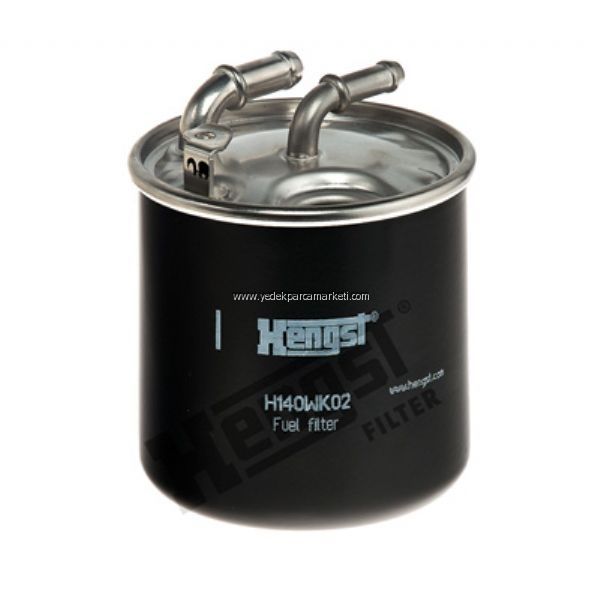
To replace the filter you will need:
- jack;
- stand;
- a set of open-end wrenches;
- bucket or basin;
- new filter.
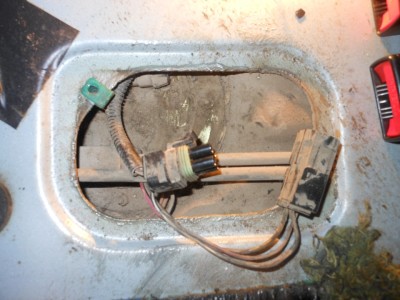
Park the vehicle on level ground and turn on and off the fuel pump. To do this, pull out its fuse or remove the power wires from it (you will need to remove the mats from the trunk and open the pump hatch). When the pressure in the fuel system drops, the engine will stall. Turn off the ignition, turn on the first gear (parking mode on the automatic transmission) and the handbrake. Raise the rear left side of the car. How to do it safely, read the article (replacement and restoration of shock absorbers). If you can get to the filter without removing the wheels, then work like this. If not, then unscrew the nuts and remove it. On some vehicles, the pump is mounted on the rear right side, so make sure the pump is on the side you jacked up before removing the wheel.
Unscrew the tips of the fuel line and pull them out of the filter. Substitute a bowl or bucket under them. When gasoline stops dripping, remove the container and unscrew the clamp mounting bolt and remove the filter. Install a new filter, do not forget to put new sealing rings. Fasten the clamp, tighten the lugs, turn on the ignition and check that the connections are not leaking. Do not turn off the ignition for 5 minutes. If the leak does not appear, you did everything right. If you find a fuel leak, turn off the ignition and tighten the tips. Then check again. If everything is OK, install the wheel, tighten the wheel nuts and lower the car from the jack.
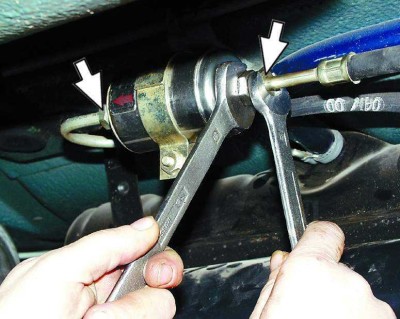
Replacing the high pressure filter (pump under the hood)
- To replace you will need:
- a set of open-end wrenches;
- rag;
- new filter.
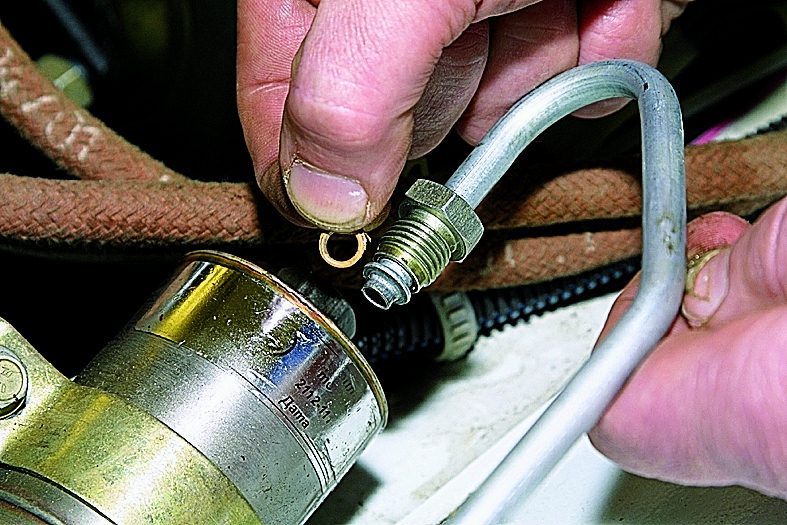
Relieve fuel system pressure as described above. Put a rag on and disconnect the battery. Unscrew the tips of the fuel pipes and move them to the sides. unscrew the clamp bolt and remove the filter. Install a new filter (do not forget to replace the copper sealing rings), fasten the clamp and tighten the tips. Turn the ignition on and see if there is any leakage. If everything is normal within a minute, start the engine and let it run for 5 minutes. If found, stop the engine, disconnect the battery and tighten the tips. Wipe off the gasoline droplets with a rag and check for leaks again.
Conclusion
Replacing the fuel filter is a simple but important event, the condition and resource of the motor directly depend on the timeliness and correctness of which. Follow the recommendations from the article, take your time, be careful and careful, this will help you properly change the fuel filter on your car.







